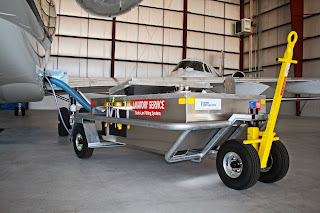Simple Ways to Improve Crew Safety on the Ramp
The airside is one of the most dynamic, fast-moving, and dangerous work environments. Workers perform heavy labor, they work exposed to the elements, they’re often required to operate heavy machinery and specialized vehicles, and they have to contend with the risk of vehicles operating in close proximity.
Those vehicles are heading in all directions, and vary greatly in size and speed. That includes aircraft tugs and tractors hauling baggage trains, other ground support equipment (GSE) vehicles, and of course aircraft. Thousands of tons (and millions of dollars worth) of aircraft on the ramp need to be serviced, and the safety of crews and passengers is at stake. A safe airside work environment is of absolute importance.
Training and More Training
This may be something of a cliché to anyone who manages grounds crews and GSE, but perhaps the simplest way to improve airside crew safety is training, training, and more training. Ensure that the entire ground crew is trained on every piece of GSE they use, and that each GSE vehicle is only accessible to those certified to operate it. There can be a tendency to suggest that someone trained on the use of one pushback tractor or tug will have the skills necessary to drive any GSE vehicles. That’s never a good idea. All airside vehicles handle differently, and require specific training.
Invest in Safe GSE
The other element of a safe work environment is safe, updated equipment. If an aircraft tug comes with automatic safety features like proximity alarms or overstress warning alarms for towing (or is compatible with their installation), it’s a safer vehicle. Embracing safety technology features on the airside might mean replacements or upgrades, but it’s an investment that pays off. In addition to making the work safer for the operator, investing in safer GSE can proactively prevent damage to aircraft.
Effective Communication
Effective communication is absolutely crucial to airside safety. That includes ensuring that crew members are familiar with the necessary contacts for questions and emergencies. It means effective communication between both crews and their leadership, and those crews with other airside crews, airport personnel, air traffic control, flight crews, and everyone else who makes decisions at an airport. It also means effective communication strategies. For instance, handing out safety pamphlets to crews describing safety procedures may be less effective than recorded safety and training videos showing processes clearly, step-by-step. Pertinent communication and safety information should also be posted in clear view around the workspaces.
About AERO Specialties
AERO Specialties has established a reputation as a respected and trusted supplier in the aviation industry. As aviation ground support equipment (GSE) providers, they’re trusted by civilian and military aviation crews for offering unmatched GSE for airports and FBOs, including private, regional, corporate, and commercial partners. The AERO Specialties team specializes in supplying user-friendly, reliable, safe used and new GSE. Part of that success is due to the fact that every AERO Specialties team member is trained to be entirely familiar with all of their GSE. Whether your aviation business needs a reliable, powerful, safe, and efficient aircraft tow tractor or a variety of the best LED multipurpose marshalling wands in a selection of colors, you can trust AERO Specialties.
Make your airside safer with AERO Specialties’ selection of industry-leading GSE, at Aerospecialties.com
 |
| Aircraft Tug |
Training and More Training
This may be something of a cliché to anyone who manages grounds crews and GSE, but perhaps the simplest way to improve airside crew safety is training, training, and more training. Ensure that the entire ground crew is trained on every piece of GSE they use, and that each GSE vehicle is only accessible to those certified to operate it. There can be a tendency to suggest that someone trained on the use of one pushback tractor or tug will have the skills necessary to drive any GSE vehicles. That’s never a good idea. All airside vehicles handle differently, and require specific training.
Invest in Safe GSE
The other element of a safe work environment is safe, updated equipment. If an aircraft tug comes with automatic safety features like proximity alarms or overstress warning alarms for towing (or is compatible with their installation), it’s a safer vehicle. Embracing safety technology features on the airside might mean replacements or upgrades, but it’s an investment that pays off. In addition to making the work safer for the operator, investing in safer GSE can proactively prevent damage to aircraft.
Effective Communication
Effective communication is absolutely crucial to airside safety. That includes ensuring that crew members are familiar with the necessary contacts for questions and emergencies. It means effective communication between both crews and their leadership, and those crews with other airside crews, airport personnel, air traffic control, flight crews, and everyone else who makes decisions at an airport. It also means effective communication strategies. For instance, handing out safety pamphlets to crews describing safety procedures may be less effective than recorded safety and training videos showing processes clearly, step-by-step. Pertinent communication and safety information should also be posted in clear view around the workspaces.
About AERO Specialties
AERO Specialties has established a reputation as a respected and trusted supplier in the aviation industry. As aviation ground support equipment (GSE) providers, they’re trusted by civilian and military aviation crews for offering unmatched GSE for airports and FBOs, including private, regional, corporate, and commercial partners. The AERO Specialties team specializes in supplying user-friendly, reliable, safe used and new GSE. Part of that success is due to the fact that every AERO Specialties team member is trained to be entirely familiar with all of their GSE. Whether your aviation business needs a reliable, powerful, safe, and efficient aircraft tow tractor or a variety of the best LED multipurpose marshalling wands in a selection of colors, you can trust AERO Specialties.
Make your airside safer with AERO Specialties’ selection of industry-leading GSE, at Aerospecialties.com



Comments
Post a Comment